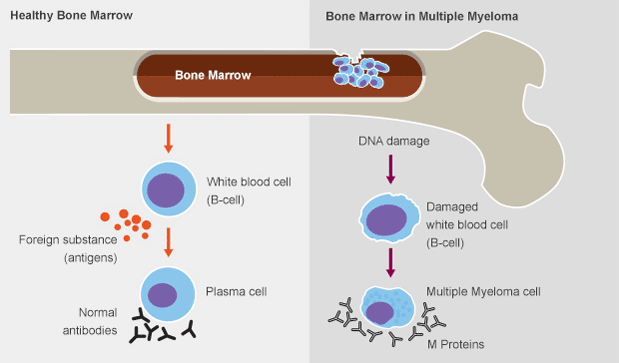Multiple Myeloma Causes, Symptoms, Diangosis and Treatment

What Is Multiple Myeloma?
Multiple myeloma is a cancer of plasma cells, a type of white blood cell normally responsible for producing antibodies.
In multiple myeloma, collections of abnormal plasma cells accumulate in the bone marrow, where they interfere with the production of normal blood cells.
Most cases of multiple myeloma also feature the production of a paraprotein—an abnormal antibody which can cause kidney problems. Bone lesions and hypercalcemia (high blood calcium levels) are also often encountered
Myeloma often affects many places in the body, which is why it is called multiple myeloma. Commonly affected areas include the spine, skull, pelvis and ribs.
Complications of multiple myeloma include:
- Frequent infections.
- Bone problems.
- Reduced kidney function.
- Low red blood cell count (anemia).
Causes Of Multiple Myeloma:
It’s not clear what causes myeloma.
Multiple myeloma begins with one abnormal plasma cell in the bone marrow. The abnormal cell multiplies rapidly.
Because cancer cells don’t mature and then die as normal cells do, they accumulate, eventually overwhelming the production of healthy cells.
In the bone marrow, myeloma cells crowd out healthy white blood cells and red blood cells, leading to fatigue and an inability to fight infections.
Risk Factors Of Multiple Myeloma:
- Increasing age. Risk of multiple myeloma increases as one age, with most people diagnosed in their mid-60s.
- Male sex. Men are more likely to develop the disease than are women.
- Black race. Blacks are about twice as likely to develop multiple myeloma as are whites.
- History of a monoclonal gammopathy of undetermined significance (MGUS).
Symptoms Of Multiple Myeloma:
The following signs and symptoms are exhibited:
- Bone pain, especially in the spine or chest
- Nausea
- Constipation
- Loss of appetite
- Mental fogginess or confusion
- Fatigue
- Frequent infections
- Weight loss
- Weakness or numbness in legs
- Excessive thirst
- less commonly, bruising and unusual bleeding – such as frequent nosebleeds, bleeding gums and heavy periods
Diagnosis Of Multiple Myeloma:
The following tests help confirm the diagnosis:
- Blood tests
- Urine test
- Examination of bone marrow
- Imaging test, to detect bone problems associated with multiple myeloma.
CT scan
X-ray
MRI
PET scan
Treatment Of Multiple Myeloma:
The following treatment options are available:
- Targeted therapy.
- Biological therapy.
- Chemotherapy.
- Corticosteroids.
- Stem cell transplantation.
- Radiation therapy.
By : Natural Health News




